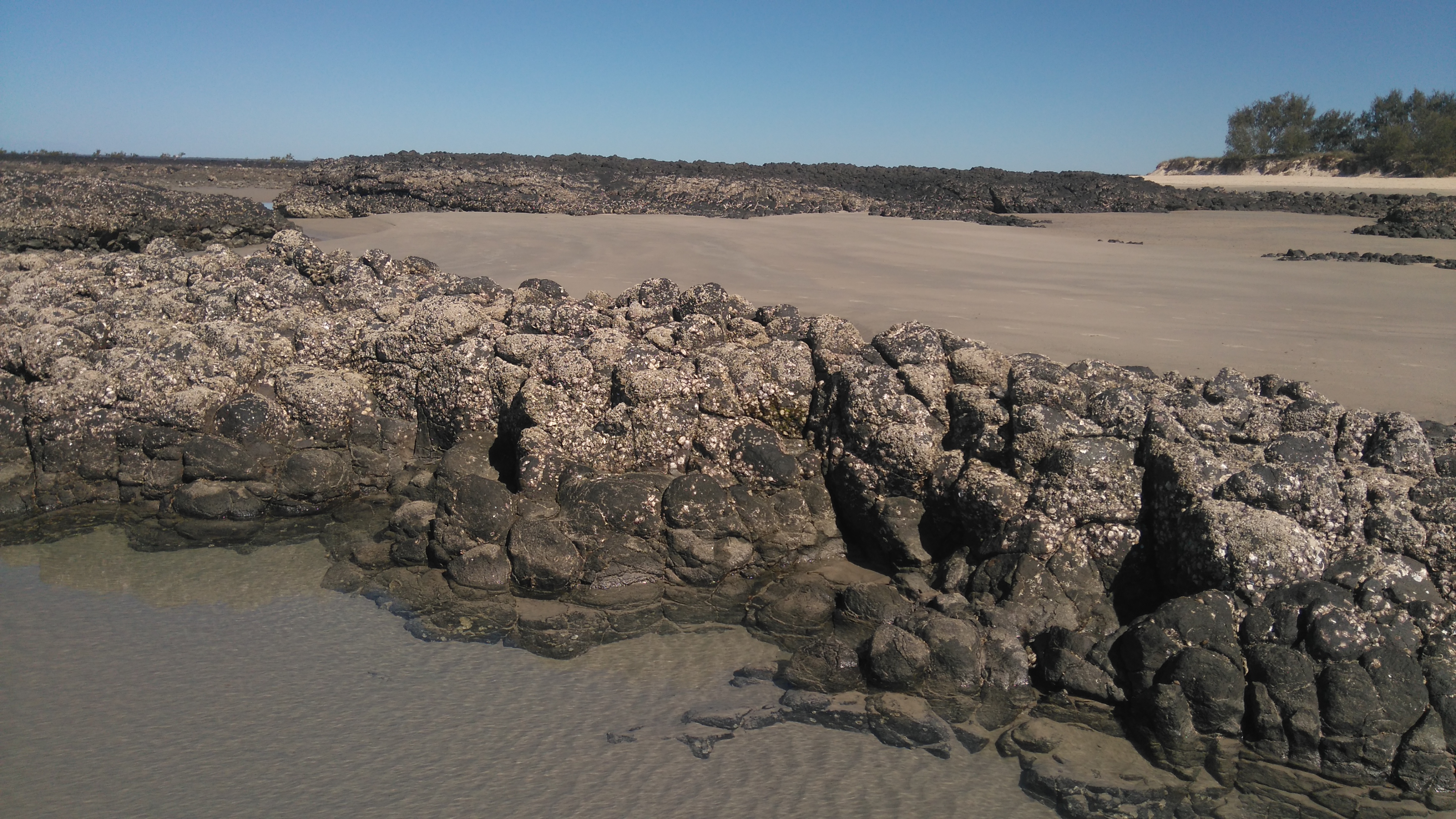|
|
Intertidal molluscs on consolidated substrate (shellfish reefs)Short descriptionMollusc communities forming shellfish reefs, typically dominated by oysters with or without barnacles, growing on intertidal rocky shores including rock platforms and pavement. Disclaimer: Ecosystem type descriptions are based on biophysical attributes identified in Central Queensland through expert advice and supported by scientific literature. Not all ecosystem types are mapped based on current inventory, and many of the ecosystems described here may also occur in other parts of Queensland.
Classification categoriesSelect from the links below to view related ecosystem type categories Long descriptionMollusc communities on intertidal rocky shores including rock platforms and pavement. Fourteen species of bivalve mollusc are known to form shellfish reef ecosystems, with their extent in Queensland poorly known[2]. Other shellfish ecosystems grow on, or form, consolidated ecosystem types. These ecosystems are typically dominated by the oysters (Ostraeidae) Saccostrea cucullata (milky oyster) and Saccostrea glomerata (rock oyster)[2], with or without barnacles, mostly from the family Chthamalidae and Balanida but also Lepadidae[1]. A range of temperate, sub-tropical and tropical biota can also occur, including encrusting algae, erect macrophyte algae, bryozoans, chitons (Chitonidae), limpets (Patellidae, Patelloididae, Fissurellidae, Siphonariidae), periwinkles (Littorinidae), top shells (Trochidae), turban shells (Turbinidae), nerite shells (Neritidae) and other gastropods (e.g. Planaxidae, Thaiidae, Mytilidae), hydroids (Dynamena crisoides), zoanthids (Zoanthidea), sea stars (Asteroidea), anemones (Actinia tenebrosa, Cnidopus verater) and polychaeta worms (Onuphidae, Serpulidae)[1]. Other shellfish ecosystems grow on unconsolidated substrates. Isignomon ephippium (leaf oyster) can also be found on these consolidated substrates but is typically habitat forming on mud and sand[2]. See types (20, 64, 65, 118). Special valuesOysters and mussels are ecosystem engineers that create shellfish reefs that provide, modify and maintain habitats for a range of other species. Shellfish reefs provide a range of ecosystem services, including food provision, fish and invertebrate habitat, water filtration, fish production and shoreline protection[2]. For thousands of years, Traditional Owners caught and ate large numbers of shellfish species in and around the Queensland coast. Often they would cook the meat and use the shells for a number of purposes, or dispose of shells in large dump sites called shell middens. Shell middens have provided important information and clues about Traditional Owners and the environment they lived in. The middens tell the story of the Traditional Owners’ diet, food sources and species available and the impact of environmental changes on biodiversity and marine ecosystems[4]. Can form a habitat of modified Naturalness (e.g. rock walls and jetties). Artificial shellfish reefs are an emerging technology designed to treat and improve water quality. Diagnostic attributesInundation 'Intertidal – Lower low', 'Intertidal – Mid low', 'Intertidal – Upper low', 'Intertidal – Low undifferentiated', 'Intertidal – Lower medium', 'Intertidal – Upper-medium', 'Intertidal – Medium undifferentiated', 'Intertidal – High', 'Intertidal – Undifferentiated', 'Intertidal – High undifferentiated' Structural macrobiota 'Mollusc – other', 'Mollusc – oyster', 'Mollusc – scallop', 'Mollusc – barnacles' Consolidation 'Consolidated' QualifiersModified ecosystems (e.g. oyster leases) are unmapped. Oysters and barnacles may also occur on modified consolidated ecosystems (type 24). DistributionTropical species typically occur north of approximately 25 degree south with temperate species to the south of this boundary[1][3]. This boundary coincides with a change in wave energy from high wave energy Fraser Island southward to low wave energy within the Great Barrier Reef lagoon[3]. In northern Queensland, the oyster Crassostrea amasa was the most conspicuous fauna and covered most of the rocky substrate between high water neap and mean sea level (i.e. upper intertidal). In southern Queensland, on high energy shorelines, this upper intertidal zone was dominated by the Rose Barnacle (Tesseropora rosea) and very few oysters are present. There is a very small area of overlapping temperate and tropical species around the latitude 25 degrees south. The Moreton Bay-Caloundra region also provides refuge for some tropical species[1]. Zonation patterns differ to the north and south of this biogeographical boundary. In northern Queensland, the oyster C. amasa dominates the upper intertidal with the large barnacle Tetraclita squamosa dominating the lower intertidal. In southern Queensland (and New South Wales), the serpulid tube-building polychaete Galeolaria caespitosa dominates in the lower intertidal and the barnacle T. rosea dominates the upper intertidal[1]. Artificial reef construction is underway across parts of Queensland including Moreton Bay and the Noosa River to provide artificial habitat and treatment systems to uptake nutrients and other potential contaminants. The following relates to distribution of this ecosystem type within the Central Queensland mapping area:
CommentsTypically intertidal oyster ecosystems occur on low energy consolidated substrates[1] although this is not a diagnostic attribute. Changes in Energy source and magnitude can also modify which species will be present. Additional InformationShellfish Reef Restoration Network References
Last updated: 22 July 2019 This page should be cited as: Department of Environment, Science and Innovation, Queensland (2019) Intertidal molluscs on consolidated substrate (shellfish reefs), WetlandInfo website, accessed 25 June 2024. Available at: https://wetlandinfo.des.qld.gov.au/wetlands/ecology/aquatic-ecosystems-natural/estuarine-marine/descriptions/116/ |

 — Department of Environment, Science and Innovation
— Department of Environment, Science and Innovation


